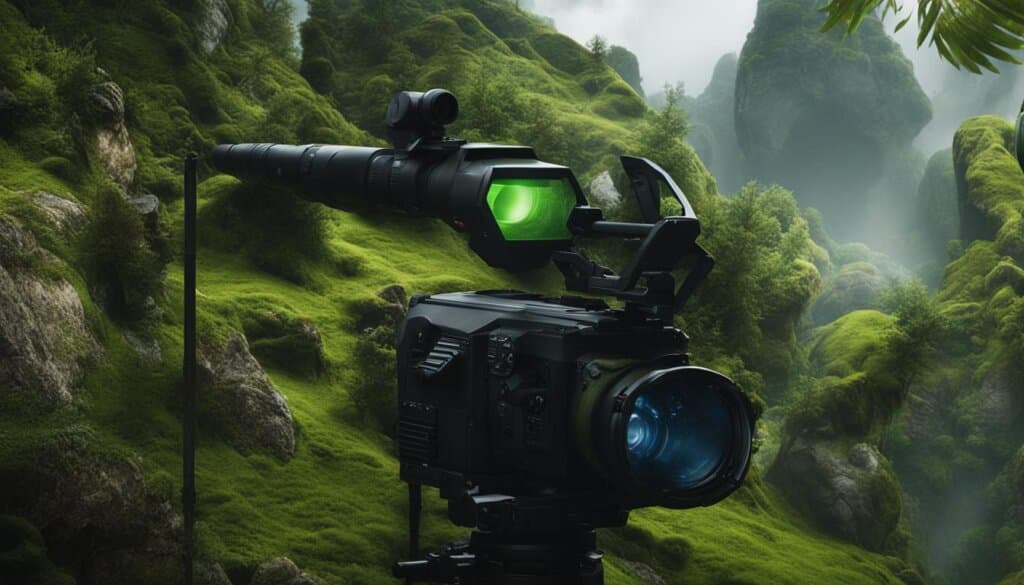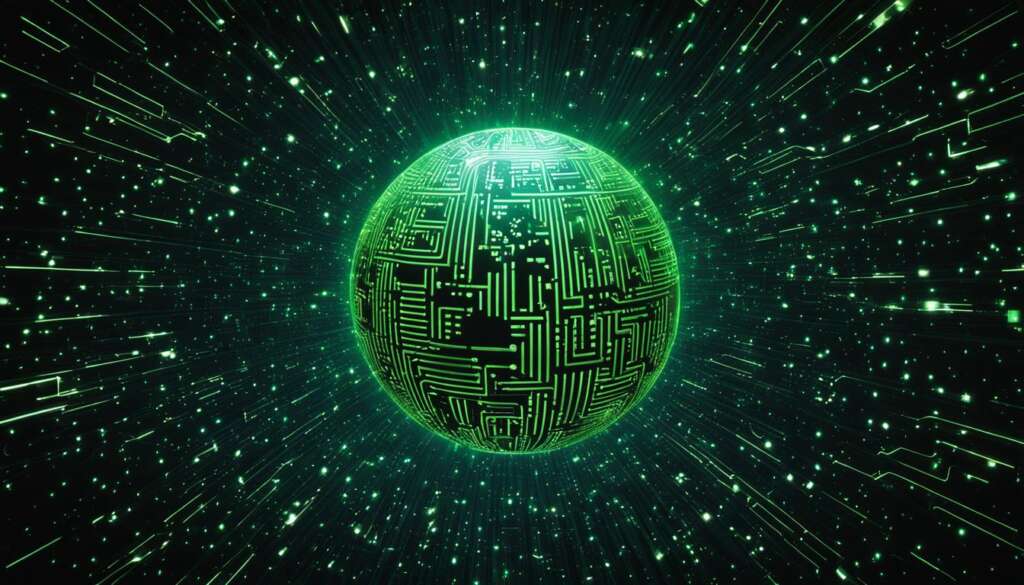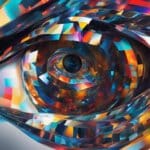Table of Contents
Welcome to our comprehensive guide on CGI, also known as computer-generated imagery. In this article, we will explore the world of digital imagery, visual effects, and animation. CGI is a powerful tool used across various industries, including visual art, advertising, architecture, film, video game art, augmented reality, and virtual reality.
CGI involves the creation of still or animated visual content using imaging software. It encompasses the use of algorithms for generating visual patterns, as well as the creation of 2D and 3D animations and special effects. With CGI, artists can bring their creative visions to life by seamlessly blending computer-generated images with live-action footage.
Throughout this article, we will delve into the definition of CGI, its process, techniques, and applications. We will also explore the history of CGI, including significant milestones and its use in notable movies and TV shows. Additionally, we will discuss the future of CGI, the role of AI and VR, and innovative techniques in CGI.
So, if you’re intrigued by the world of CGI and want to understand its essentials, you’ve come to the right place. Let’s dive in and explore the fascinating world of computer-generated imagery and its impact on various forms of media!
What is CGI and how does it work?
CGI, or computer-generated imagery, is the creation of visual content using computer software. It involves a combination of techniques and processes, including 2D and 3D modeling, texturing, animation, and compositing. CGI has revolutionized the world of film and animation, allowing filmmakers to bring their creative visions to life with stunning visual effects.
CGI in film and animation is used to create realistic visuals and seamlessly integrate computer-generated images with live-action footage. It has become an integral part of the filmmaking process, enhancing storytelling and delivering immersive cinematic experiences. Whether it’s the jaw-dropping battles in superhero movies or the imaginative worlds of animated films, CGI plays a crucial role in transporting audiences to new dimensions.
Let’s take a closer look at the CGI process:
- Concept and Pre-production: A clear vision and concept are developed, and the necessary assets, such as models and textures, are created.
- Modeling and Texturing: 2D or 3D models are created, giving shape and dimension to the digital objects. Textures are then applied to add realism and detail.
- Animation: The models are animated, bringing them to life through movement and expression.
- Rendering: The final frames are rendered, resulting in high-quality images or videos.
- Compositing: The CGI elements are integrated into the live-action footage, blending seamlessly to create a unified visual experience.
CGI techniques continue to evolve, pushing the boundaries of what is visually possible on the screen. From epic battles to fantastical creatures, CGI enables filmmakers to create captivating worlds and characters that capture the imagination of audiences.
“CGI in film and animation has transformed storytelling, opening up a world of visual possibilities that were once unimaginable.”
In conclusion, CGI is a powerful tool that enhances the visual quality of films and animations, allowing filmmakers to create stunning visual effects and bring their creative visions to life. Whether it’s crafting realistic environments, animating fantastical creatures, or pushing the boundaries of imagination, CGI is an indispensable component of modern filmmaking and animation.
Main Use Cases and Examples of CGI
CGI, or computer-generated imagery, offers a wide range of applications across various industries. Let’s explore some of the main use cases and examples of CGI in film, video games, advertising, and architecture.
CGI in Film
In the film industry, CGI is widely used to create realistic special effects, transform characters, and enhance the background or environment. This technology has revolutionized the way movies are made, allowing filmmakers to bring their imaginative visions to life. Two iconic examples of CGI in film are Terminator 2, known for its groundbreaking visual effects, and Jurassic Park, which showcased realistic computer-generated dinosaurs.
CGI in Video Games
CGI plays a crucial role in the development of video games by rendering stunning 3D graphics and creating immersive virtual environments. With CGI, game designers can create lifelike characters, realistic landscapes, and breathtaking visual effects. This enables players to engage with a virtual world that feels truly immersive and captivating.
CGI in Advertising
In the advertising industry, CGI is used to create visually captivating imagery that showcases products in the most appealing way. Whether it’s a car commercial where the vehicle is showcased in a stunning environment or a beauty advertisement where visual effects enhance the appearance of a product, CGI helps bring advertising campaigns to life and capture the attention of consumers.
CGI in Architecture
Architects and designers utilize CGI to visualize their creations before construction begins. With CGI, they can create photorealistic 3D models of buildings, enabling clients to grasp the design concept and visualize the final result. CGI in architecture allows for accurate representations of lighting, textures, and materials, aiding in effective communication and decision-making during the design process.
By harnessing the power of CGI, these industries can achieve remarkable visual experiences that would not be possible with traditional methods alone. Whether it’s the awe-inspiring visual effects in movies, the immersive virtual worlds of video games, the captivating imagery in advertisements, or the realistic architectural renderings, CGI continues to push the boundaries of what is visually achievable.

History of CGI use
Over the years, CGI has undergone significant evolution, revolutionizing the visual effects industry and leaving a lasting impact on movies and TV shows. Several notable milestones mark the journey of CGI, demonstrating its remarkable progress and groundbreaking contributions to the world of digital imagery.
In 1958, Alfred Hitchcock’s iconic film Vertigo became the first movie to utilize CGI. Although the technology was in its infancy, the film’s dream sequence showcased the potential of computer-generated imagery in enhancing storytelling.
In 1972, the short film A Computer Animated Hand paved the way for the introduction of 3D computer graphics. This groundbreaking work by Ed Catmull and Fred Parke demonstrated the possibilities of creating realistic, computer-generated visuals.
Since then, CGI has continued to push boundaries, with many unforgettable films showcasing its capabilities. Movies such as Tron, Jurassic Park, Toy Story, Titanic, and The Lord of the Rings trilogy have revolutionized the use of CGI, captivating audiences with their immersive and visually stunning effects.
“CGI has transformed the art of filmmaking, enabling filmmakers to bring their imaginative worlds to life with breathtaking visual effects.” – Renowned film director Steven Spielberg
The groundbreaking use of CGI in Tron in 1982 showcased the potential of computer-generated imagery as an integral component of futuristic storytelling. This cult classic film introduced audiences to a digital world, blending live-action footage seamlessly with imaginative computer-generated environments.
In 1993, Jurassic Park shocked and enthralled audiences with its lifelike dinosaurs, made possible through CGI. These astonishingly realistic creatures elevated the film to new heights, forever transforming the way visual effects were used in cinema.
The advent of Toy Story in 1995 marked a milestone in CGI animation, as it became the first feature film entirely created using computer-generated imagery. Pixar Animation Studios, in collaboration with Walt Disney Pictures, brought toys to life on the big screen, capturing the hearts of both children and adults worldwide.
Building on the success of Toy Story, James Cameron’s 1997 blockbuster Titanic employed CGI to recreate the majestic ship and its ill-fated journey. The film’s visually stunning effects helped transport audiences back in time, immersing them in the tragic tale of the unsinkable ship.
The epic fantasy adventure The Lord of the Rings trilogy, released between 2001 and 2003, pushed the boundaries of CGI in its extensive use of digital effects. From breathtaking landscapes to captivating creatures like Gollum, the films showcased the power of CGI in creating immersive and visually stunning worlds.
These milestones in the history of CGI demonstrate its evolution from its humble beginnings to its current state as a prominent tool in the visual effects industry. CGI continues to shape the world of filmmaking, allowing artists to create extraordinary worlds and awe-inspiring visual spectacles.
Key Milestones in the Evolution of CGI:
| Year | Movie/Event |
|---|---|
| 1958 | Vertigo – First use of CGI in a film |
| 1972 | A Computer Animated Hand – Introduction of 3D computer graphics |
| 1982 | Tron – Groundbreaking use of CGI in creating a digital world |
| 1993 | Jurassic Park – Lifelike CGI dinosaurs revolutionize visual effects |
| 1995 | Toy Story – First feature film entirely created using CGI |
| 1997 | Titanic – CGI recreates the ill-fated ship and its journey |
| 2001-2003 | The Lord of the Rings trilogy – Extensive use of CGI in creating immersive worlds |
Future of CGI
The future of CGI holds exciting possibilities as advancements in technology, particularly in AI and deepfake technology, continue to shape its trajectory. While AI has made significant strides in recent years, it is unlikely to replace CGI artists entirely in the foreseeable future. However, AI integration can enhance the efficiency and effectiveness of CGI workflows.
One area where CGI is poised to make a significant impact is in virtual reality (VR) experiences. By combining CGI with VR technology, creators can transport users into immersive, lifelike virtual environments. This convergence of CGI and VR opens up endless possibilities in fields such as gaming, architecture, training simulations, and entertainment, creating unparalleled interactive experiences.
Another area where CGI is at the forefront is deepfake technology. Deepfakes refer to the use of AI algorithms to manipulate or replace elements in digital content, including images and videos. While deepfakes have raised ethical concerns, they also showcase the potential of CGI advancements. As AI algorithms continue to improve, the ability to seamlessly blend real and computer-generated elements will become even more convincing, offering new avenues for creativity and storytelling.
As technology continues to evolve, CGI will remain a vital tool in various industries. Its ability to create stunning visuals, realistic effects, and immersive experiences makes it an essential component in fields such as film, advertising, gaming, architecture, and more. The future of CGI holds promise for further advancements, pushing the boundaries of creativity and blurring the line between reality and fantasy.
CGI in Architecture Visualization
CGI plays a vital role in architecture visualization by enabling the creation of photorealistic images that showcase buildings and landscapes. Architects and designers use advanced 3D modeling software to develop detailed 3D models of their designs, offering a realistic representation of the final result. These models are then enhanced with textures and lighting to mimic real-world materials and lighting conditions, resulting in stunning images that accurately portray the design.
This integration of CGI in architecture visualization serves multiple purposes, facilitating effective client communication and aiding in marketing efforts. By providing clients with visually compelling representations of the proposed design, CGI enables them to fully understand and appreciate the project. This level of realism helps to overcome potential communication barriers and allows for informed decision-making throughout the architectural process.
One significant advantage of CGI in architecture visualization is its ability to generate highly detailed and accurate visuals. The precision of 3D modeling ensures that even the smallest architectural elements and intricate features are accurately represented, enhancing the overall quality of the visualization. Additionally, CGI enables architects to experiment with various materials, textures, and lighting conditions, empowering them to make informed design choices.
“The use of CGI in architecture visualization provides architects and designers with a powerful tool to showcase their vision and capture the essence of their designs.”
Moreover, CGI offers significant time and cost savings compared to traditional physical model making. With CGI, architects can create virtual environments that simulate lighting conditions and test different design iterations efficiently. Furthermore, CGI eliminates the need for frequent physical modifications, reducing material and labor costs.
The Impact of CGI in Architectural Marketing
CGI has revolutionized architectural marketing by enabling the creation of captivating visuals that attract clients and investors. Photorealistic images generated using CGI allow potential buyers to envision the completed project in its intended setting. This immersive experience greatly influences decision-making, as clients are more likely to invest in a design they can visually connect with.
With the help of CGI, architects can now showcase their designs in a variety of marketing materials, including brochures, websites, and presentations. These visually stunning representations, accompanied by convincing narratives, help promote the architectural project effectively, ensuring a competitive edge in a crowded marketplace.
Ultimately, CGI in architecture visualization has become an indispensable tool for architects and designers, enabling them to bring their ideas to life and communicate effectively with clients. By combining advanced 3D modeling, textures, and lighting techniques, CGI creates engaging and realistic visuals that enhance the architectural design process from concept to completion.
Captivating Benefits of CGI in Architecture Visualization:
| Benefits of CGI in Architecture Visualization | Descriptions |
|---|---|
| Enhanced Visual Realism | CGI enables the creation of highly realistic and accurate architectural visuals, including intricate details and materials. |
| Effective Communication | CGI helps architects effectively communicate their ideas to clients, facilitating better understanding and decision-making. |
| Cost and Time Savings | CGI eliminates the need for physical model making and allows for efficient design iterations, resulting in cost and time savings. |
| Marketing Appeal | Photorealistic CGI visuals attract clients and investors, increasing the desirability and marketability of architectural projects. |
Innovative CGI Techniques
CGI techniques in movies have revolutionized the world of visual effects, continuously pushing the boundaries of creativity and realism. With advanced technology and skilled artists, filmmakers have been able to create stunning visuals that captivate audiences and bring imaginary worlds to life.
Realistic CGI Spacesuits
One fascinating application of CGI in movies is the creation of realistic spacesuits. In films like “The Martian,” CGI is used to craft intricate and lifelike spacesuits that enable actors to appear as if they are exploring the vastness of space. The attention to detail, from the textures to the reflective surfaces, adds authenticity to these scenes.
Photorealistic Crowd Scenes
CGI has also been instrumental in generating photorealistic crowd scenes. In movies like “Toy Story” and “The Incredibles,” CGI is used to create vibrant and dynamic backgrounds filled with animated characters. Through careful rendering and animation, these crowd scenes contribute to the immersion and realism of the storytelling.
Enhancing Realism with CGI Food
Food scenes in movies have become more tantalizing and visually appealing with the help of CGI. Using computer-generated techniques, filmmakers can create mouthwatering dishes that look incredibly realistic on screen. From towering cakes to sizzling steaks, CGI food enhances the sensory experience and adds an extra layer of detail to these scenes.
Detailed Digital Replicas of Environments
CGI also allows filmmakers to create detailed digital replicas of real-world environments. Whether it’s a bustling cityscape or an ancient mythical realm, artists can meticulously construct these environments using CGI techniques. The level of intricacy and attention to detail in these digital worlds is truly awe-inspiring.
From creating realistic spacesuits and crowd scenes to enhancing food visuals and crafting detailed environments, CGI techniques continue to amaze and immerse audiences in captivating cinematic experiences.
Benefits of CGI and its use in other forms of media
Computer-generated imagery (CGI) offers numerous advantages in creating visual content that is highly realistic and visually complex. One of the key benefits of CGI is its ability to produce photorealistic visuals that can be indistinguishable from real-world objects or environments. This level of realism allows filmmakers, advertisers, and game developers to immerse their audiences in stunningly detailed and visually captivating experiences.
Unlike traditional media forms, CGI provides unlimited creative possibilities. With CGI, artists and designers are not bound by the constraints of physical materials, gravity, or practical effects. They can create visuals that would be difficult or impossible to achieve through other means. This freedom of expression enables filmmakers to bring imaginative and fantastical worlds to life, advertisers to showcase products in visually dynamic ways, and game developers to construct richly immersive virtual environments.
Furthermore, CGI offers the advantage of an unlimited budget. Unlike practical effects or elaborate set designs, where budget constraints can limit the scope and scale of visual storytelling, CGI allows creators to manifest any vision without financial limitations. This opens up new possibilities for filmmakers, advertisers, and game developers to realize ambitious and visually breathtaking projects.
CGI is not only prevalent in movies but also finds extensive use in other forms of media. TV commercials benefit from CGI’s ability to create realistic visuals of products, making them more visually appealing and captivating to consumers. Additionally, CGI plays a pivotal role in video games, where it is utilized to construct immersive virtual worlds, realistic characters, and breathtaking visual effects, enhancing the overall gaming experience.
FAQ
What is CGI?
CGI stands for computer-generated imagery. It is the creation of visual content using imaging software, including still and animated visuals. CGI is used in various industries, such as visual art, advertising, engineering, film, and video game art.
How does CGI work?
CGI involves the use of algorithms and computer software to create visual content. It includes techniques such as 2D and 3D modeling, texturing, animation, and compositing. In film and animation, CGI is used to create realistic visual effects and integrate computer-generated images with live-action footage.
What are some main use cases of CGI?
CGI is used in various industries and applications. In film, it is used for creating special effects and enhancing visuals. In video games, CGI is used for rendering 3D graphics and creating immersive environments. It is also used in advertising to market products with captivating imagery and in architecture to create photorealistic 3D models of buildings.
Can you provide some examples of CGI in movies?
Yes, movies like Terminator 2 and Jurassic Park used CGI for realistic special effects and to modify character appearances. CGI has also been showcased in films like Tron, Toy Story, Titanic, and Lord of the Rings, demonstrating advancements in CGI technology.
What does the future hold for CGI?
The future of CGI involves advancements in technology, such as the potential use of AI and VR. While AI may play a role in CGI, it is unlikely to replace CGI artists. VR has the potential to revolutionize CGI and create more immersive experiences. CGI will continue to play a significant role in various industries as technology evolves.
How is CGI utilized in architecture visualization?
CGI is commonly used in architecture visualization to create photorealistic images of buildings and landscapes. Architects and designers use 3D modeling software to create detailed 3D models of their designs, which are then textured and lit to mimic real-world materials and lighting conditions.
What are some innovative CGI techniques used in movies?
Innovative CGI techniques include creating realistic CGI spacesuits, generating photorealistic crowd scenes, creating CGI food for realistic food scenes, and creating detailed digital replicas of real-world environments.
What are the benefits of CGI and where else is it used?
CGI offers benefits such as creating highly realistic and complex visuals, unlimited creative possibilities, and the ability to achieve visuals that may be difficult or impossible with other forms of media. CGI is not only used in movies but also in TV commercials and video games, creating realistic visuals of products and immersive environments.













